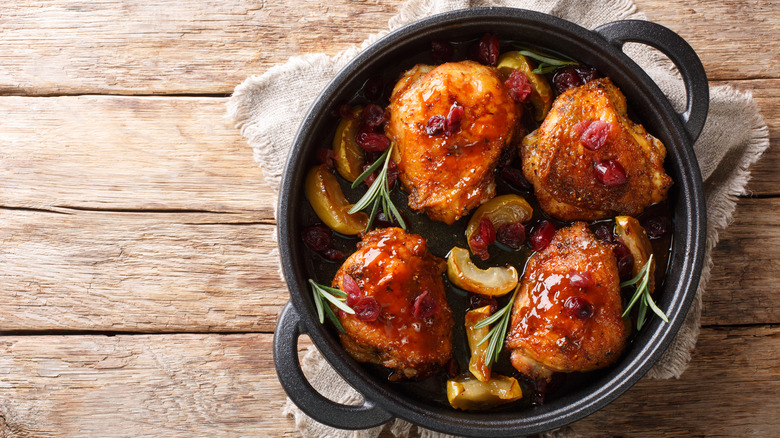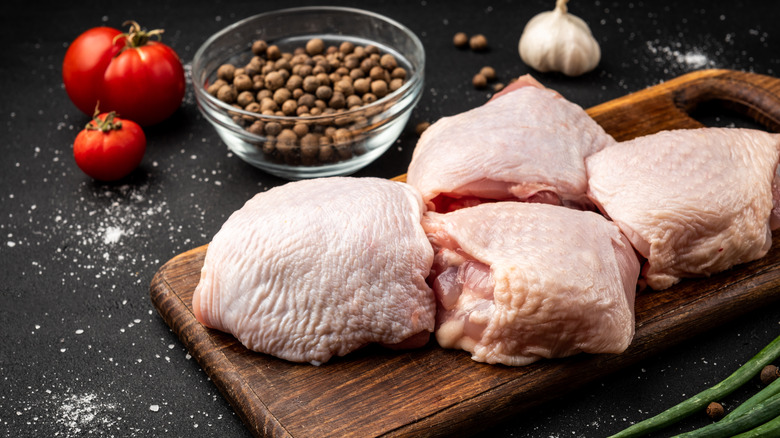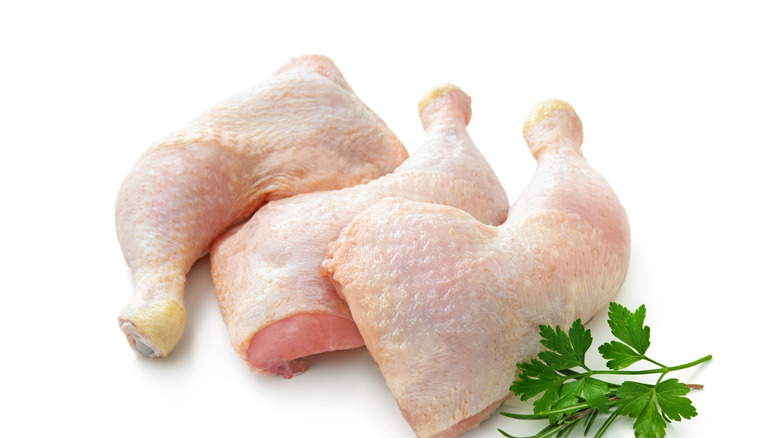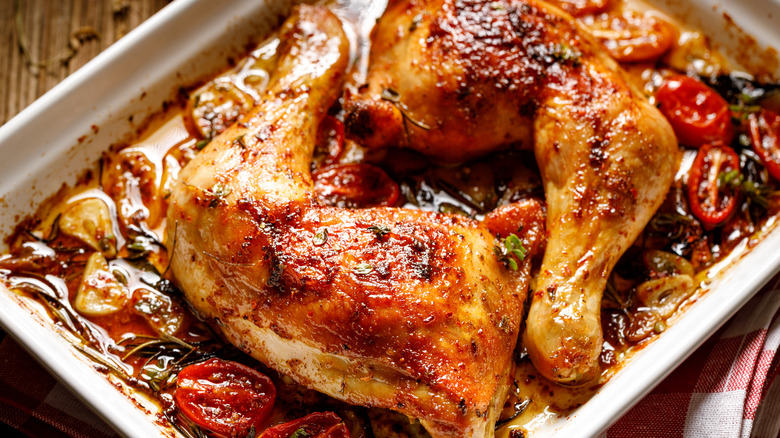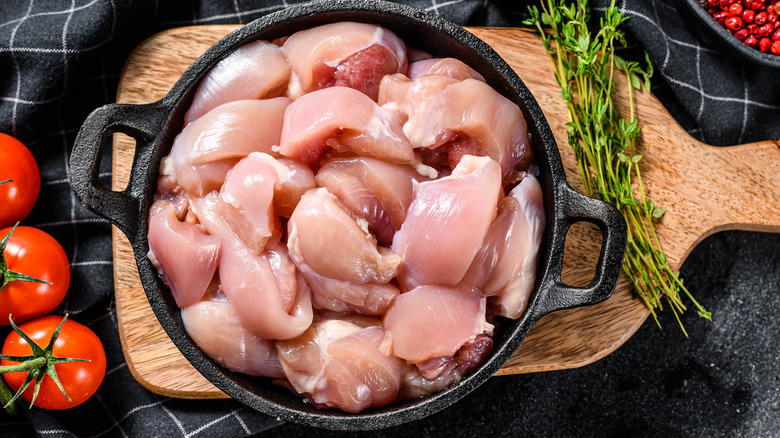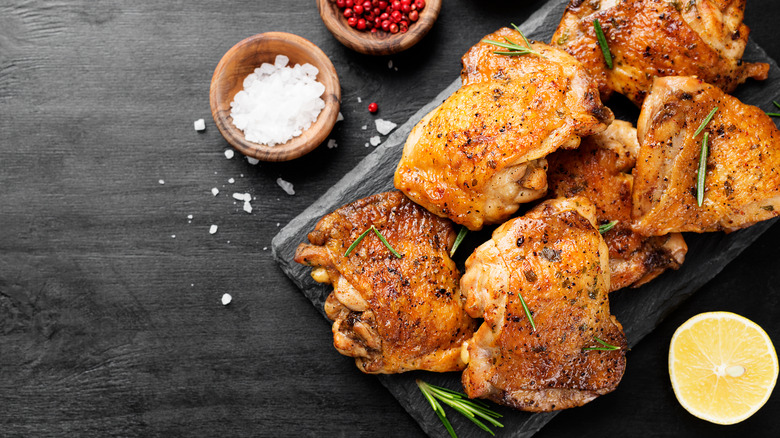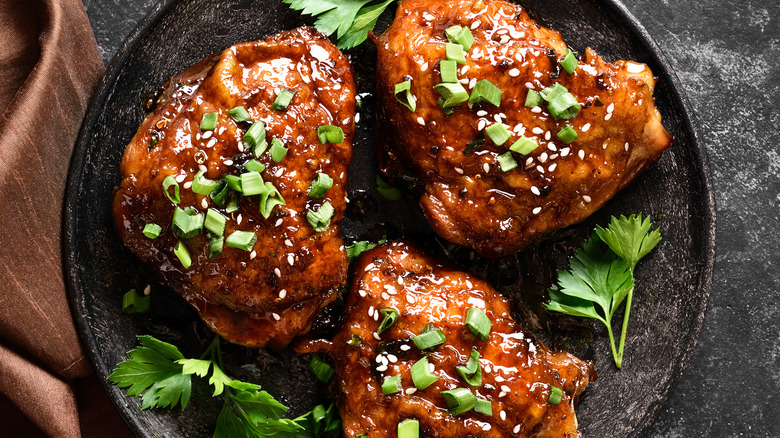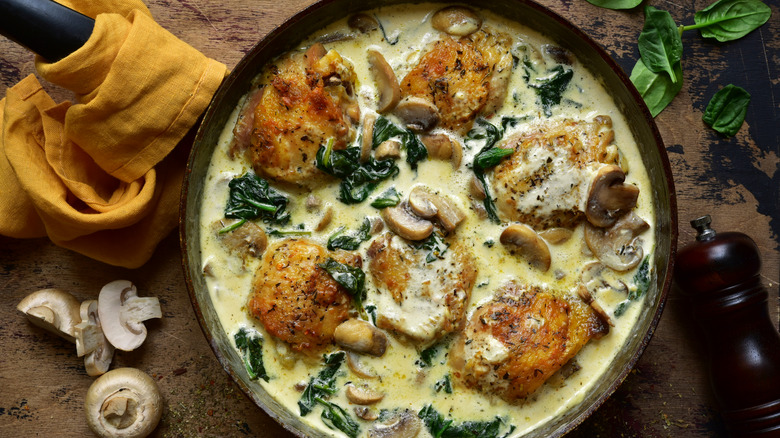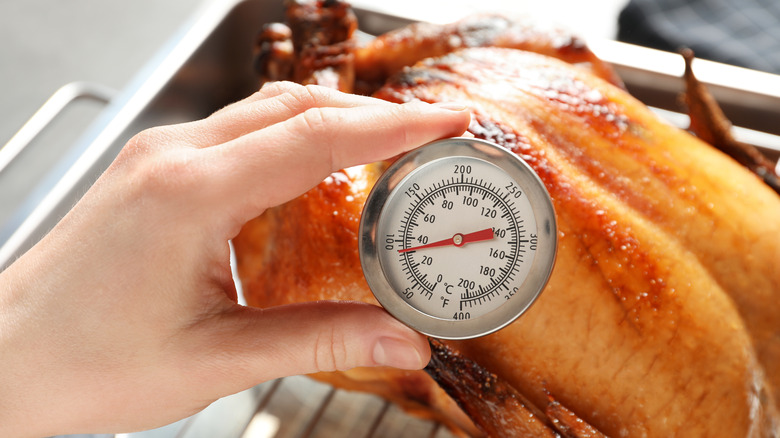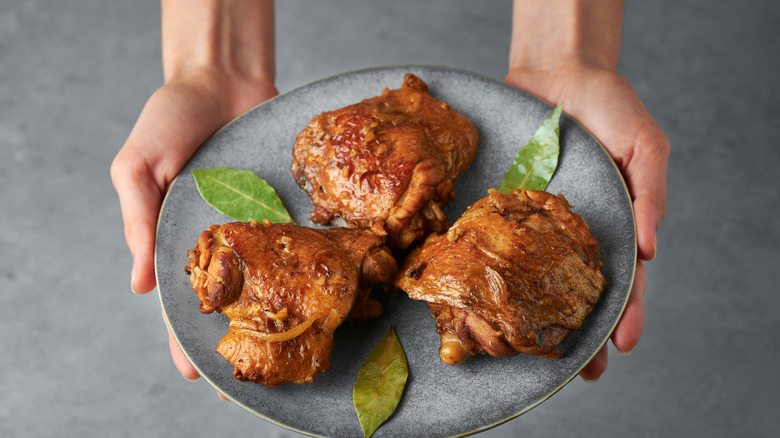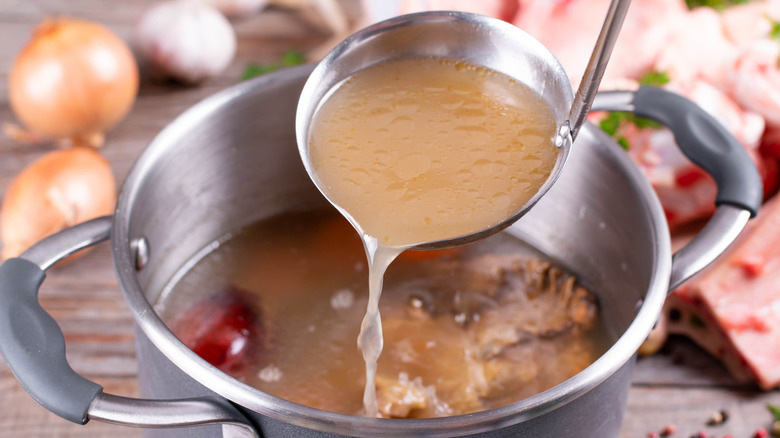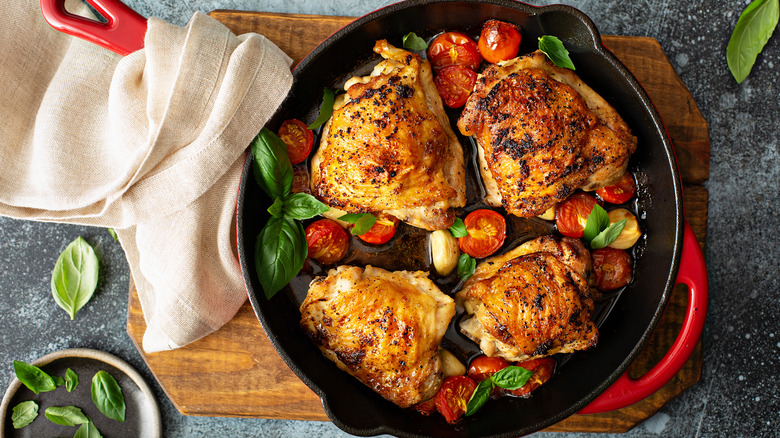Mistakes Everyone Makes When Cooking Chicken Thighs
Most meat-eaters probably consume chicken on a regular basis. There are endless ways of using this lean protein in a nutritious and filling meal, whether it's grilling, frying, roasting, or baking. Some home chefs may stick to boneless, skinless chicken breasts because of their perceived ease and overall approachability. Chicken breasts are quite pretty and neat, especially when compared to other cuts.
Chicken breasts are clean and don't have any bones or an abundance of fat, making them an easy item to mindlessly throw in your cart and figure out how to use later. However, bone-in chicken thighs are full of flavor and just as versatile as breasts, even if they might require a little bit more effort. Many home cooks are prone to overlooking chicken thighs. The flab of skin, the oddly-placed center bone, and the dark meat aspect can all be intimidating.
However, it's these factors that make this cut of meat so amazing. Additionally, chicken thighs are quite affordable. It's important to understand the best way of using chicken thighs and the techniques that yield the tastiest result possible. There are a few mistakes nearly everyone makes at some point when cooking chicken thighs.
Before delving into the world of chicken thighs, it's essential to educate yourself about some of the most common mistakes people make when cooking this protein. Hopefully, this will inspire you to try a new recipe and deviate from your typical chicken dinner to create something delicious and different.
Buying them frozen
It can be convenient to buy meat in bulk and properly stock your freezer so that you have whatever you need on hand. You may be tempted to peruse the freezer aisle for frozen chicken thighs to save yourself time at the meat counter. However, this almost always leads to dry chicken that is not as juicy as the fresh options, even if you end up freezing it yourself.
Chicken that is frozen for commercial purposes is subjected to saline injections before freezing, making the meat extra salty (via Livestrong). If you decide to purchase fresh chicken and then freeze it, it's important to remember that although chicken can technically last indefinitely in the freezer, a whole chicken is best consumed within a year of freezing (via USDA).
Smaller parts of a chicken, such as giblets, can last up to several months after freezing. If using frozen chicken, it's important to plan your meals and defrost accordingly and safely. It's usually always preferred to season anything that you are cooking to your preferred taste, particularly meat, as this can be an easy way to throw off a recipe and end up with a dish you may not love.
Using boneless and skinless cuts
Not everyone is super gung-ho about butchering meat on their own. Sometimes, the bones and other unidentifiable skin parts may appear unappetizing to some people. If you're going to eat meat, though, it's good to be conscious in all regards, including making it as enjoyable as possible. That's why bone-in, skin-on chicken thighs are the only way to go.
First of all, if you leave chicken skin on, it's perfect for crisping up and adding texture to a meal. Even if fried chicken skin isn't your thing (though it's downright delicious), the skin also protects the meat from burning: The thighs cook completely, stay tender, and the meat falls off the bone upon serving.
Bone-in chicken is also cheaper (via Bon Appétit). Less processing time goes into removing the bone, which affects the overall price. The bones might add slight weight to the total, but a pack of bone-in chicken thighs will be a fraction of whatever you're paying for breast meat.
The bones add flavor to the meat that cannot be replicated with marinades and seasoning. This is because, when cooked, the delicious bone marrow and fat from in and around the bone melts inside and makes the chicken extra juicy. If serving chicken with the bone isn't your thing, it's also very easy to debone the thigh yourself before cooking (via White Kitchen Red Wine).
Washing the chicken
If you're buying chicken parts with the bones, fat, and gristle, you may be tempted to rinse the meat before really starting your recipe. Home chefs all over the world have their reasons for doing this: Some believe it's dirty to not wash off your meat while others do it out of habit. However, in general, washing your chicken actually puts you more at risk for food poisoning, according to the CDC.
Washing chicken can result in the raw meat liquids spreading to other parts of the kitchen like the sink basin, countertops, and cutting boards, which are at risk for cross-contamination. Chicken is one of those proteins that needs to be prepared right or it can easily make you sick. It's better to skip the rinse altogether, especially with skin-on chicken thighs, as it can separate the meat from that protective outer casing.
As long as you ensure that your chicken is cooked to the correct temperature, it will eliminate any bacteria in the meat, giving you a finished meal that is safe to consume.
Forgetting to dry out the skin
If you do decide to leave the skin on, there's a key step to making sure that it's a crispy treat rather than a rubbery mess that you end up sliding to the edge of your plate: Drying out the skin. At the very least, you want to pat the skin of your chicken thighs totally dry with a paper towel before seasoning them or putting them in the pan.
Brining the thighs in salt draws moisture to the skin and it's an even better way of drying out the skin (via Bon Appétit). You can also let your salted chicken thighs sit uncovered in your fridge for at least an hour before cooking to ensure that the chicken attains a juicy flavor inside and a crisp exterior upon cooking.
There are other ways of ensuring that chicken skin turns out crisp, such as Alton Brown's technique of steaming chicken first so that the fat is rendered to the surface. Baking powder can go a long way in giving your chicken the crispiest skin, regardless of the cut.
Putting cold chicken in a hot pan
One major transformative tip that will improve the way that you cook meat, particularly on a grill, is letting it rest at room temperature beforehand. Putting cold meat on a hot pan might be great for searing; however, cooking with cold meat can make the outside of your protein is more prone to burning before the inside is cooked all the way through. As HelloFresh head chef Claudia Sidoti told Eat This, Not That, "Room temperature meat cooks more evenly and fewer juices will leak while cooking."
Unlike a thick steak, you don't want to leave chicken thighs on the counter for 45 minutes before cooking. A quick 15 minutes is long enough to get the meat to room temperature without taking any unnecessary food safety risks. This technique requires a bit of patience, but it will ultimately lead to better-finished dishes and creations.
Overcrowding the pan
It can seem like a time-saver to cook an entire batch of chicken thighs in one massive pan at the same time, but it almost always leads to negative outcomes as far as flavor. When a Reddit user questioned why so much liquid was emanating from the chicken while it was being cooked in a pan, another user posited that the culprit may have been an overcrowded pan.
Adding chicken to the pan tends to bring down the temperature of the oil. As the user wrote, "Water that would normally evaporate right away in a ripping hot pan will now stick around for a bit to steam the chicken. The problem is compounded the more chicken you add – the pan temp is lower, more water is expelled." The solution is to cook chicken in batches so that the liquid can evaporate more evenly and to ensure that the pan is able to reach peak heat in between each batch.
Under-seasoning the meat
Chicken thighs are so versatile that they work with several different seasonings. They can be combined with spicy, sweet, or savory flavors. Chicken thighs are also suited to numerous cuisines; whether you follow a recipe, use a ready-made spice blend, or create your own combination of spices, the result is likely to be delicious.
Herbs and spices aside, the one thing that chicken absolutely needs is salt. Here's the thing about salt intake: While our cells need salt to function, sodium can also cause health issues, so it's important to regulate your intake. However, if you look at labels on packaged food, it quickly becomes apparent that the problem often stems from processed food, not homecooked food.
Generally, the best way to ensure your food has enough salt is to taste as you go; however, since it's not possible to taste raw chicken, the best thing to do is season conservatively and adjust the flavors before serving.
According to Samin Nosrat, author and host of Salt Fat Acid Heat on Netflix, salting any meat in advance results in "magic." Brining is a simple way to salt chicken thighs. Brining entails soaking the meat in salted water or buttermilk, which tenderizes the meat while adding tons of flavor. If you're short on time, a dry rub of salt (also known as a dry brine) will make chicken thighs so flavorful and juicy that you'll forget about boneless breasts completely.
Not experimenting with recipes
If you're a home chef then there are times when you can get stuck in a rut of cooking the same recipe over and over again. It can happen with any meat, including chicken thighs. Pan roasting chicken thighs with simple ingredients can be transformative; however, it tends to get old very quickly. Thankfully, we live in the age of the internet and there's no excuse for not using new and exciting ways of cooking this cost-effective cut of poultry.
There are numerous chicken recipes that will liven up your meal, such as juicy and flavorful General Tso's chicken or creamy garlic chicken made in an Instant Pot. You can experiment with making slow-cooked butter chicken, oven-fried chicken, sweet bourbon chicken, and other exciting methods of cooking. It's way more fun to play around with the versatility of chicken than to get stuck making the same thing, regardless of your cut of choice.
Braising the chicken with a lid on the pot
Braising, the classic technique of searing meat and simmering it gently in stock or wine, isn't only for tough cuts of beef. Chicken is the star of dishes that contain some elements of braising, such as cacciatore and coq au vin. Braising may seem complex, but it's actually a relatively straightforward process. Chicken thighs are excellent for braising because the fat emanates from the skin and adds tons of flavor to the dish; however, if your recipe directs you to braise chicken with the lid on, beware.
On the surface, it makes sense to submerge the meat in liquid and to use a tight-fitting lid during cooking; underdone chicken is definitely not ideal. But considering that low and slow is the name of the braising game, nestling the chicken atop the vegetables and keeping the skin side exposed is a better plan. The oven's heat and the sauce bubbling around the meat results in fully cooked chicken with crispy skin, which is far more appealing than flabby skin simmered in sauce.
Braised chicken suits several different cuisines; cacciatore is Italian and coq au vin French. For a Mediterranean twist, braise chicken thighs with garlic, lemon, and olives. If chicken curry is on your mind and you have a can of coconut milk in the pantry, you're good to go. As long as you ensure that you leave the lid off the pot, you can savor delicious chicken any night of the week.
Not using a meat thermometer
The most fool-proof way to perfectly cook any cut of chicken is by using a meat thermometer (via CDC). Chicken needs to reach an internal temperature of 165 F to be considered safe to eat. This means that occasionally, the skin can burn and turn black while the inside isn't quite cooked through. The best way of figuring out the internal temperature is by placing the tool in the thickest part of the meat without touching the bone or any large pieces of fat.
An instant-read thermometer will only take a second to generate a reading while older versions may take longer to tell you the exact temperature (via Clemson University). There are so many legends and hacks to figuring out if meat is cooked through, but nothing beats and tried and true thermometer.
If you're someone who struggles with grilling, this one tool could completely transform your cooking. It's also the simplest way to make cooking chicken thighs less intimidating because it allows you to ensure you won't get food poisoning while also figuring out the best flavors for your chicken.
Being impatient
Patience is pivotal to cooking: This advice is extra useful when it comes to chicken thighs. According to America's Test Kitchen, overcooking chicken thighs leads to meat that is more tender. Dark meat is better when overcooked, as the connective tissue breaks down and seeps into the thigh meat. It's best to remain patient and let the chicken thighs cook slowly, let them reach an internal temperature between 175 F and 195 F, and avoid a direct flame so that the skin doesn't get too burnt.
The thigh meat will fall off the bone and will be bursting with real chicken flavor. However, it's best to not let the internal temperature reach above 210 F as the meat will be stringy and far too overcooked. It's crucial to keep a close eye on your thermometer. That said, an overcooked chicken thigh will not taste the same as an overcooked chicken breast, which should give you more wiggle room in the kitchen, allowing you to cook with increased peace of mind.
Not saving the bones to make stock
One of the main reasons to choose bone-in chicken thighs instead of boneless cuts is because the skin and bones offer lots of incredible flavors. The skin adds a wonderfully crispy texture, and the bones help lengthen the cooking process by conducting heat, which renders a juicy, delectable flavor that boneless chicken lacks. Additionally, if you toss the bones in the trash after eating, you're missing out on the fantastic opportunity of turning chicken bones into stock.
Making homemade stock is an easy, money-saving project that repurposes scraps into a versatile ingredient that is rich in nutrients. Stock can be used in soups, sauces, risottos, and casseroles, and it can also be frozen for later use. Homemade stock is easy to whip up: All you have to do is combine water, chicken bones, veggie scraps, herbs, and seasonings.
If you don't have enough bones from one meal, just keep a scrap bag in the freezer and add bones and bits of assorted vegetables from your regular prep work. The skins and ends from onions, carrots, or celery are also perfect for this bag. Once your scrap bag is full, it's time to make stock. Whether it simmers on the stove all day or cooks in the crock pot, homemade stock is an essential staple that is used in many recipes.
Discarding the fat
Over the past several decades, fat has become the enemy, which is why chicken thighs often lag behind boneless chicken breasts in many people's menu plans. While there's no doubt that boneless breasts have earned their place since they're easy to cook and versatile enough to work seamlessly in dishes from any cuisine, this shouldn't stop you from branching out.
Chicken thighs stay succulent and flavorful because the fat they contain helps baste the meat constantly. If you often drain the fat away, please stop! Chicken fat is a natural fat, meaning it's much better for you than manufactured fats.
Industrialized fats and some cooking oils (corn, canola, and grapeseed oils) are quite damaging to our health. These fats become unstable at high temperatures, forming free radicals that cause cell damage and disease. However, natural fats remain stable, which is why they are better for the body.
Chicken thighs are juicier and less pricey than boneless breasts. They are an important part of a well-rounded, healthy diet that includes nutritious vegetables and whole grains (via Eating Well).
Instead of fearing the fat from chicken thighs, use it to enhance those delicious sides. Imagine making garlic butter chicken thighs and using the sauce over veggies and brown rice, or honey mustard chicken thighs served with quinoa and roasted vegetables. The limits for maintaining healthy habits while enjoying delicious food only exist in the mind.
